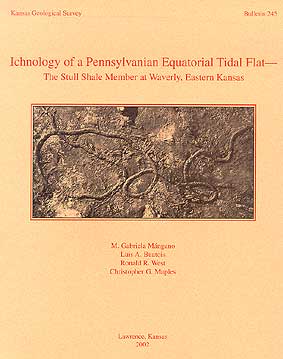Ichnology of a Pennsylvanian Equatorial Tidal Flat--The Stull Shale Member at Waverly, Eastern Kansas
M. Gabriela Mángano, Luis A. Buatois, Ronald R. West, and Christopher G. Maples
Bulletin 2452002
133 pages, 78 figures, and references

Kansas Geological Survey Publications Sample
Ichnology of a Pennsylvanian Equatorial Tidal Flat--The Stull Shale Member at Waverly, Eastern KansasM. Gabriela Mángano, Luis A. Buatois, Ronald R. West, and Christopher G. MaplesBulletin 2452002 133 pages, 78 figures, and references |
 |
| A full online version of this publication is not available. Copies of this publication are available from the publications office of the Kansas Geological Survey (785-864-3965). The cost is $30 per copy, plus sales tax, shipping and handling. | |
Integrated stratigraphic, sedimentologic, and ichnologic analyses indicate that the Stull Shale Member (Kanwaka Shale, Shawnee Group) at Waverly (Coffey County, eastern Kansas) was deposited along a microtidal shoreline directly connected with the open sea and outside of a northeast-southwest-oriented embayment. Six major subenvironments have been identified in the lower interval of the Waverly section: sand flat, mixed flat, mud flat, supratidal paleosols, intertidal runoff channels, and fluvial channel. Paleogeographic information indicates that the position of the Waverly tidal flat was equatorial.
Trace fossils are extremely abundant and diverse in the tidal-flat deposits, where 41 ichnotaxa have been recognized. This tidal-flat ichnofauna includes Arenicolites isp., Asteriacites lumbricalis, Chondrites? isp., Conichnus conicus, Cruziana problematica, Cruziana isp., Curvolithus simplex, Curvolithus multiplex, Diplocraterion isp. A, Diplocraterion isp. B, Halopoa isp., Lockeia ornata, Lockeia siliquaria, Nereites cambrensis, Nereites imbricata, Nereites jacksoni, Nereites missouriensis, Palaeophycus tubularis, Parahaentzschelinia ardelia, Pentichnus pratti, Phycodes palmatus, Phycodes isp., Phycosiphon incertum, Planolites beverleyensis, Protovirgularia bidirectionalis nov. isp., Protovirgularia rugosa, Psammichnites grumula, Psammichnites implexus, Psammichnites plummeri, Psammichnites? isp., Rhizocorallium irregulare, Rosselia socialis, Rusophycus isp., Skolithos isp., Teichichnus rectus, Trichophycus isp., chip-shaped burrows, pelletoidal chains, small horizontal cylindrical burrows, small vertical burrows, and undetermined trackways. In addition, a monospecific suite of the myriapod trackway Diplichnites cuithensis is present in the fluvial deposits toward the upper part of the lower interval. Vertical changes in diversity and abundance of trace fossils in the lower interval of the Waverly section reflect an overall shallowing-upward trend.
The Waverly tidal flat is characterized by the heterogeneous distribution of biogenic structures. At a large scale, zonational distribution is shown by different associations of trace fossils in sand-, mixed- (sand and mud), and mud-flat areas of the tidal flat. High abundance and diversity of ichnofossils in sand-flat deposits record the activity of a rich benthic community. In contrast, mixed- to mud-flat deposits contain a lower diversity of biogenic structures, reflecting more stressful conditions and, to a lesser extent, low preservation potential. At a smaller scale, heterogeneity occurs within each particular zone of the tidal flat, reflecting partitioning of energy resources.
The tidal-flat ecosystem is subject to extreme changes in environmental conditions, with temperature, salinity, time of subaerial exposure, energy, and substrate representing limiting factors. Changes in salinity and temperature, together with time of subaerial exposure, are extreme in the upper-intertidal zone and diminish toward the lower-intertidal zone, leading to an increase in ichnodiversity from the mud- and mixed-flat facies to the sand-flat deposits at Waverly. Overall features of the Waverly ichnofauna suggest a moderate- to low-energy coastal setting, punctuated by high-energy erosional events. Substrate consistency was also highly variable, playing a significant role in trace-fossil morphologic variability.
Analysis of the Waverly tidal-flat deposits also provides information on stratigraphic completeness. A complex sequence of colonization events separated by erosional scouring and renewed deposition is recorded by amalgamated sandstones with preferential preservation of Lockeia siliquaria. These bedding planes represent time-averaged surfaces recording the work of successive bivalve communities.
Careful examination of crosscutting relationships, burrowing depth, burrow-wall sharpness, trophic types, and bauplan allows recognition of a tiering structure and ichnoguild model for the Waverly tidal-flat ichnofauna. This tidal-flat community essentially occupied shallow tiers, with traces of bivalves (Lockeia siliquaria, Protovirgularia bidirectionalis) and sea anemones (Conichnus conicus) being the deepest forms in the association.
The sedimentary units of the lower interval of the Waverly succession include four fining-upward parasequences of tidal-flat progradation, separated by successive flooding surfaces. These four parasequences make up a progradational parasequence set. A major transgressive surface separates the fluvial facies at the top of the lower parasequence set from the subtidal orthomyalinid packstones and wackestones, which form a retrogradational parasequence set. Paleosols developed at the top of the Waverly tidal-flat parasequences during regressive maxima; consequently, they do not represent sequence boundaries. The Glossifungites ichnofacies occurs locally as part of some high-energy transgressive surfaces.
The Waverly softground assemblage represents an example of the Cruziana ichnofacies in intertidal environments, which reflects shallower water than expected based on standard ichnofacies models. We suggest that the classic onshore-offshore ichnofacies replacement model should be applied only to wave-dominated systems because the opposite gradient is commonly observed in ancient and modern tide-dominated systems.
Heterogeneity, unrefined interactions, predictability, and high selective pressures may have promoted evolutionary innovations in tidal-flat ecosystems. Comparative analysis of tidal-flat ichnofaunas through time supports the view of tidal flats as sites of evolutionary innovations and subsequent offshore migration. In the Waverly tidal flats, the presence of the bivalve Wilkingia and relatively deep bivalve burrows suggests incipient exploitation of the deep infaunal ecospace by bivalves, long before the Mesozoic revolution. This tidal-flat, bivalve-dominated ichnofauna differs from early Paleozoic trilobite-dominated trace-fossil assemblages and from post-Paleozoic crustacean- and polychaete-dominated intertidal ichnofaunas.